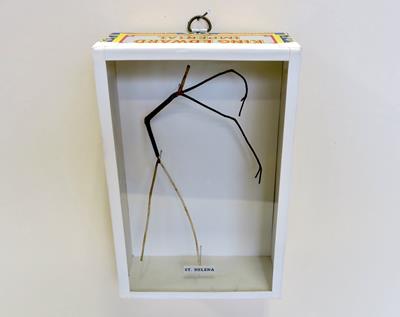Chris Kenny
St Helena
Construction with found twig
£365.00 (framed)
14cm x 21cm
August 18th
Helena, a poor innkeeper's daughter, attracted the eye of Constantius Chlorus, a Roman general - they married and had a son Constantine.
Constantius was made Caesar, that is junior emperor, and was forced to take a different wife, Theodora, and so Helena had to make herself scarce.
When Constantius died, the son Constantine inherited the throne and invited his exiled mother to rejoin him as Empress, appointing her Augusta Imperatrix. She shared his Christian beliefs, which he had adopted while visiting Britain, and she embraced the religious life and carrying out many charitable acts.
Helena made the pilgrimage to Palestine and while there was instrumental in the discovery and excavation of the Holy Cross. She commemorated its reappearance with the building of churches and ordered the destruction of the obsolete Temple of Venus.
Nails from the cross were preserved in Constantine's helmet and his horse's bridle.
She kept herself busy: arranging for special soil from Golgotha to be brought to the Vatican Gardens, building a church in Egypt to identify the site of the Burning Bush of Sinai and transporting hundreds of cats to Cyprus to rid a monastery there of snakes.
Helena's birthplace, Drepanum, was renamed Helenopolis. Her skull is displayed in the Cathedral of Trier.
Evelyn Waugh wrote about her in his novel, Helena.
The Island of St Helena was named after her - it is one of the most remote islands in the world, which is why Napoleon was imprisoned there.
Helena is the patron saint of new discoveries.
Previous 55 of 78 Next
